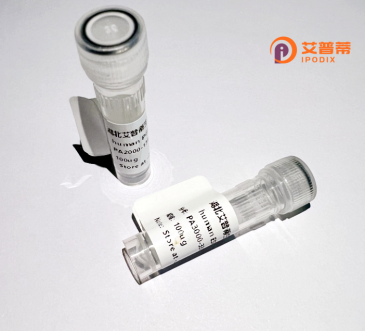
| 纯度 | >90%SDS-PAGE. |
| 种属 | Human |
| 靶点 | TEK |
| Uniprot No | Q02763 |
| 内毒素 | < 0.01EU/μg |
| 表达宿主 | E.coli |
| 表达区间 | 1-237 aa |
| 活性数据 | MNIFDRKINFDALLKFSHITPSTQQHLKKVYASFALCMFVAAAGAYVHMVTHFIQAGLLSALGSLILMIWLMATPHSHETEQKRLGLLAGFAFLTGVGLGPALEFCIAVNPSILPTAFMGTAMIFTCFTLSALYARRRSYLFLGGILMSALSLLLLSSLGNVFFGSIWLFQANLYVGLVVMCGFVLFDTQLIIEKAEHGDQDYIWHCIDLFLDFITVFRKLMMILAMNEKDKKKEKK |
| 分子量 | 52.9 kDa |
| 蛋白标签 | GST-tag at N-terminal |
| 缓冲液 | PBS, pH7.4, containing 0.01% SKL, 1mM DTT, 5% Trehalose and Proclin300. |
| 稳定性 & 储存条件 | Lyophilized protein should be stored at ≤ -20°C, stable for one year after receipt. Reconstituted protein solution can be stored at 2-8°C for 2-7 days. Aliquots of reconstituted samples are stable at ≤ -20°C for 3 months. |
| 复溶 | Always centrifuge tubes before opening.Do not mix by vortex or pipetting. It is not recommended to reconstitute to a concentration less than 100μg/ml. Dissolve the lyophilized protein in distilled water. Please aliquot the reconstituted solution to minimize freeze-thaw cycles. |
以下是3篇与重组人TEK(Tie2)蛋白相关的研究文献概括:
1. **文献名称**:*Structure of the receptor tyrosine kinase Tie2 in the apo and ligand-bound conformation*
**作者**:Barton MJ et al.
**摘要**:该研究解析了人Tie2受体在无配体和结合配体Angiopoietin-1时的晶体结构,揭示了其胞外结构域的构象变化机制,为靶向Tie2信号通路的药物设计提供了结构基础。
2. **文献名称**:*Angiopoietin/Tie2 signaling regulates tumor angiogenesis through PI3K/Akt pathway*
**作者**:Huang H et al.
**摘要**:本研究通过重组Tie2蛋白实验,证明Angiopoietin-1激活Tie2后,通过PI3K/Akt信号通路促进内皮细胞存活和迁移,阐明了Tie2在肿瘤血管生成中的调控机制。
3. **文献名称**:*Soluble Tie2 fusion protein suppresses experimental choroidal neovascularization*
**作者**:Oshima Y et al.
**摘要**:研发了一种重组可溶性Tie2受体(sTie2-Fc),并在小鼠模型中证明其可通过竞争性结合VEGF和Angiopoietins抑制病理性脉络膜新生血管生成,为眼部血管疾病治疗提供了潜在策略。
4. **文献名称**:*TEK mutations cause primary congenital glaucoma via endothelial cell dysfunction*
**作者**:Kizhatil K et al.
**摘要**:通过基因编辑和重组TEK蛋白功能分析,发现TEK突变导致内皮细胞调控房水排出功能异常,揭示了其在先天性青光眼发病中的作用。
以上文献覆盖了Tie2的结构解析、信号通路机制及疾病治疗应用等研究方向。
**Background of Recombinant Human TEK (TIE2) Protein**
TEK, also known as TIE2 (Tyrosine kinase with Immunoglobulin-like and EGF-like domains 2), is a transmembrane receptor tyrosine kinase primarily expressed on vascular endothelial cells. It plays a pivotal role in regulating angiogenesis, vascular stability, and endothelial cell survival. TIE2 interacts with angiopoietins (Ang1. Ang2. and Ang4 in humans), with Ang1 acting as its primary agonist to promote vessel maturation and quiescence, while Ang2 often functions as a context-dependent antagonist, modulating vascular plasticity during inflammation or pathological angiogenesis.
Dysregulation of the Ang-TIE2 signaling axis is implicated in vascular disorders, including hereditary venous malformations, tumor angiogenesis, and inflammatory diseases. TIE2 activation triggers downstream pathways, such as PI3K-AKT and MAPK, which mediate cellular responses like migration, proliferation, and anti-apoptotic signaling.
Recombinant human TEK protein, produced via engineered cell systems (e.g., HEK293 or CHO cells), retains the extracellular ligand-binding domain, enabling studies on receptor-ligand interactions, drug screening, and therapeutic development. It serves as a critical tool in investigating vascular biology, designing anti-angiogenic therapies for cancer, and exploring treatments for vascular anomalies. Its preclinical applications also include biomarker assays and mechanistic studies to decode pathological angiogenesis in diseases like diabetic retinopathy and atherosclerosis.
×